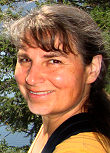Among the Big Trees
AMONG THE BIG TREES
Meares Island sits like an ancient monument in Clayoquot Sound, east of Tofino. The twin peaks of mount Colnett and Lone Cone loom over clear waters and visitors who make their way to the island’s green-rimmed shores.
In the mid-‘80s, hundreds of environmentalists, natives and area residents surrounded the island to stop loggers from cutting the old-growth cedars, hemlock and spruce here, some of the largest in the world. The Tla-o-qui declared the island a tribal park and eventually a court injunction stopped the logging.
Now, as my partner, Phil, and I approach this majestic island in a 20-foot converted fishing boat with our skipper, Art, I feel a sense of excitement anticipating our walk among these mammoth trees. I’d wanted to see these forests for many years, after discovering full-page photographs of them in several books at our local library.
The boat pulls up to a small crescent of shoreline, where half a dozen kayaks are moored. We hop out and head for the wooden boardwalk of the Big Tree Trail, visible through an opening in the green tangle of trees.
Soon, the winding trail through the forest brings us to the tail end of a small group gathered around a wide-bodied cedar, where a blond, 20-something man, obviously the group’s guide, is saying, “This one’s between 800 and 900 years old. You never get two cedar trees that look the same. They all have personalities.”
We shuffle down some stairs over a small stream to the sonorous voice of the guide, who points out a patch of bright red salal berries (which are antiseptic but edible) then tells us this area received a whopping 400 centimeters (157 inches) of rain the previous winter. This, of course, is good for the growth of the cedars, once used by the natives not only for canoes, but also for hats, capes, cooking boxes and tools of all kinds.
Farther along the path, the guide tells us that most of the Sitka spruce, which can grow to more than 91 meters (298 feet) tall, were cut down during the Second World War and used for building planes. The clear cutting of young cedar and Sitka in these coastal forests, he adds, “is really destructive.”
He points up, to our right, at the basketlike shape of a bald eagle’s nest near the spire of a Sitka —“They can get up to six feet deep… The same pair of eagles comes back every year.”
Shortly after, we arrive at a giant old cedar, a mass of trunk and spires from which small hemlock, ferns, mosses and salal bushes hang in various formations. Called “The Hanging Garden” because of these, the tree is the second-largest recorded cedar in Canada, measuring 18.3 meters (60 feet) around (the largest, with a circumference of 18.9 meters [62 feet], was discovered on the shore of Cheewat Lake in 1988). The tree is also one of the oldest, at 1,500 years, a vibrant ecosystem supporting countless insects, fungi, birds and small animals.
Phil and I follow a walkway built around the tree’s base, then take turns photographing each other. When Phil climbs part way up the trunk, he seems engulfed in the tree’s vastness, part of the ecosystem like all the other living organisms in it.
Soon, the other visitors head back down the boardwalk to their kayaks while Phil and I venture onto a muddy path, climbing over fallen trees, pushing through the jungle of salal and ferns, and scrambling over slippery, protruding roots, all surrounded by the towering cedars.
Given the overgrown state of the trail, it’s clear few visitors use it. We’d been warned by our skipper, who said he’d recently picked up a couple who had been lost for the greater part of a day on the island.
We’d figured our map would save us from this fate, but now as the path peters out into a clearing of trees, we aren’t so sure.
We’re forced to backtrack several hundred feet until we spot a telltale red trail marker tied to one of the trees. Still, it’s not until we see the tall spire of a Sitka spruce to our right, which corresponds to one marked on the map, that we know we’re on the main route.
Suddenly we realize we’re nearly out of time—we’ve arranged to meet Art at the drop-off point in less than a half-hour, and we’ve no idea how far we’ve yet to walk. Spurred on by the prospect of being stranded here overnight, we break into a run, Phil bounding nimbly into the forest ahead of me. I tread more cautiously, wary of slippery roots.
Phil seems to disappear into the brush and, afraid of losing my way down another path, I call out to him. Moments later, he yells back, farther ahead than I expect. Through thinning spaces between the trees I now see swaths of glittering blue, just at the moment I hear the faint sound of a motor offshore.
Heart pounding, sweat beading my face, I pick up my pace, bounding into the clearing towards Phil’s smiling face just as Art’s boat glides into view.
Published in The Times-Colonist and The Ottawa Citizen, summer 2005
